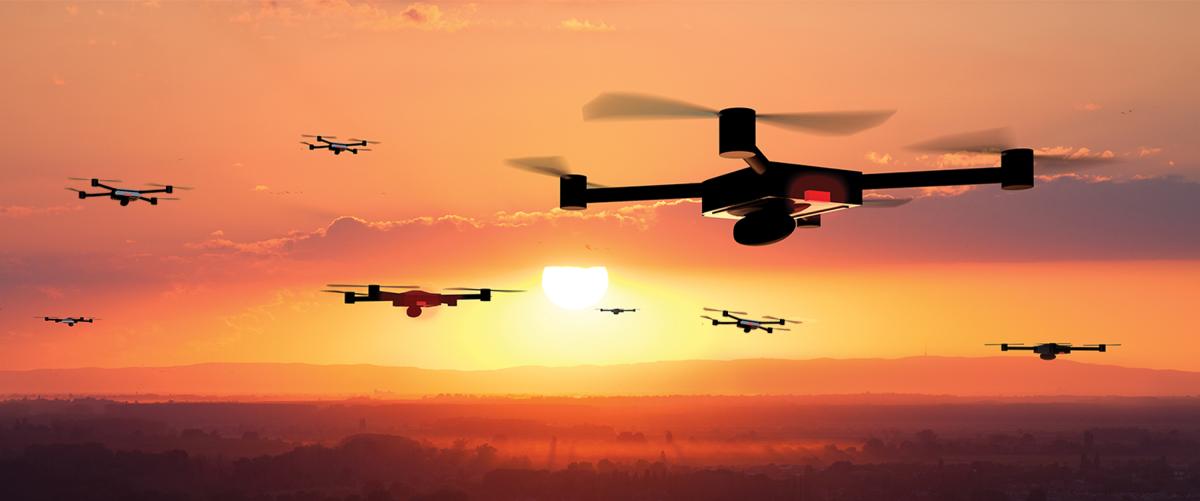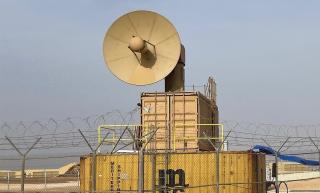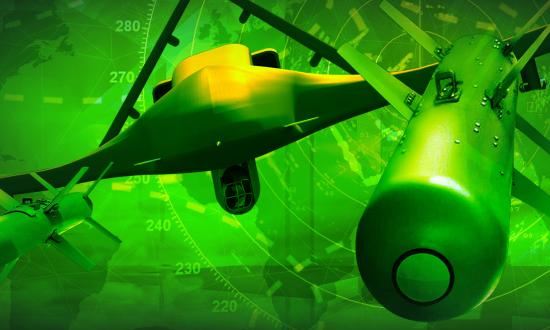South China Sea: Not-So-Distant Future
While on a freedom-of-navigation patrol in the South China Sea, the USS Dewey (DDG-105) is confronted by six People’s Armed Forces Maritime Militia (PAFMM) vessels. These vessels maneuver dangerously close and attempt to disrupt the destroyer’s transit through the area. The Dewey responds by hailing the vessels, only to be shouted down with claims of Chinese sovereignty. The Dewey continues forward as well as she can to preserve the safety of the ship and crew. Eventually, the six PAFMM vessels form a rough semicircle perimeter forward of the Dewey. At a signal transmitted in the open on VHF channel 16 by one of the vessels, each vessel’s crew opens a large container stored on the aft decks. Out of each container spring 16 small, folding-wing unmanned aerial vehicles.1 These 96 drones form concentric patterns around the Dewey that continuously shift while individual drones make swooping passes on the destroyer’s pilothouse, bow, and flight deck.
Emerging Maritime Swarm Warfare
Small unmanned aerial systems (sUASs) are carving an ever-widening niche within military maritime operations. From hand-launched scouts to ship-based surveillance platforms, sUASs show increasing utility in today’s military operations. As processing power grows, sUASs continue to increase their utility as powerful tools of observation or coordinated target saturation.
These small systems come in many forms, from tiny quadcopters to larger, lightweight fixed-wing systems. Most have camera systems. Payloads generally are restricted by size, weight, and power constraints. However, sensor and processing technology continues to advance, reducing the demands of each dimension and increasing the trade-off for offensive payloads such as explosives or short-burst directed-energy weapons. Deployment methods also vary from flight-deck launches to hand-tossed, catapult launchers, and compressed air tubes.
A single sUAS may constitute a very real threat. However, counterdrone technologies and tactics continue to advance. Swarming sUASs could present a more complex challenge. The objective of an offensive swarm is to quickly overwhelm a target, which can be done in various ways. Individual sUASs within a swarm can operate independently, network to coordinate maneuvers, collectively designate or trade targets, or possibly create a learning network on the fly to counter a target’s defenses.
Disruption
The following scenarios describe plausible disruptive capabilities a maritime drone swarm could readily execute within the current state of the art. The scenarios all begin at the end of the opening example in the South China Sea.
Scenario A: Area-Denial Strategy
The Dewey continues despite ongoing harassment by the drones. Meanwhile, five of the six PAFMM vessels have moved off in multiple directions. The sixth vessel remains several hundred yards ahead of the Dewey’s starboard bow, seemingly monitoring or directing the drones. The drones begin to tighten the concentric flight pattern around the Dewey, focusing on a three-dimensional arc over the bow and immediately in front of the pilothouse.
The Dewey’s commanding officer orders a reduction in speed and slow turn to starboard to cross astern of the PAFMM vessel and shift the drones away from the destroyer. As she comes around, the drones move yet again, concentrating on patterns off the Dewey’s port bow. The drones continue to shift while the destroyer turns to a reciprocal heading and eventually maintain a pattern astern of the Dewey. Meanwhile, the PAFMM vessel maintains its original course and speed away from the Dewey, while the drones commence a low-level spread pattern several hundred yards wide astern of her, as if herding the destroyer in the opposite direction.
In the decision space that encompasses 96 drones operating in close proximity with unknown payloads, capability, endurance, and intent, it is logical that a single ship would be deterred and turn away from the potential threat. The ship subjected to the drone harassment could be another fishing boat, a merchant ship, or a warship with different rules of engagement. Regardless of the target, ship-launched drone swarms could modify the harassment role of China’s armed fishing fleet and reduce the risk to that fleet while increasing its ability to deny safe passage through contested waters.
The past actions of the PAFMM in the South China Sea—including pursuing, ramming, and sometimes sinking fishing vessels—indicate little regard for property or life, which opens the possibilities for maritime drone payloads.2 Small concussive munitions, chemical irritants, or small explosive payloads could be used to harass fishing vessels or pose a significant risk to military ships. A maritime drone swarm with a combination of payloads could increase the uncertainty and risk of such an encounter. These risks may be enough to deny access to smaller fishing vessels and further embolden the use of maritime swarms.
Scenario B: Intrusive Surveillance
The six PAFMM vessels match the destroyer’s course and speed while the drones fly in tighter and tighter formations around the ship. The Dewey’s commanding officer, while deeply concerned, is resolved to execute the mission. After two hours, the drones begin to fall into the sea. As the last of the swarm splashes down, two new drones are launched from the nearest PAFMM vessel. The drones fly low and bracket the destroyer, one on either side, a mere 50 yards from the ship. The drones are too small to be consistently detected and tracked by the radar system. At dusk, the two drones dive into the sea and two more are launched from a PAFMM vessel. At night, the drones are nearly impossible to see against the backdrop of the ocean and cannot be tracked. At first light, two bracketing drones are spotted, and a third drone is discovered flying above the ship behind the mast.
An uncertain factor in drone swarms is the homogeneity of the swarm itself. Until recently, drone swarms were considered to consist entirely of the same type of drone. India demonstrated different drone types operating in concert to destroy targets, permanently removing the homogeneous swarm assumption.3 The options for drone swarms are limitless with respect to size and capabilities.
In this scenario, homogenous drone platforms do not imply the drones are carbon copies. Identical drone platforms may have different sensor packages. A drone may have a basic flight control system with an advanced, short-range optic. This drone may work with another that acts as a signal booster to transmit data back to a receiving station. Signal interception sensors, offensive electronic warfare packages, and optical packages including infrared and other spectrum sensors are all possible payloads for sUASs. Some of these packages on a small platform may only be a nuisance to the advanced capabilities of a ship such as the Dewey, but those capabilities will continue to improve with time and technology.
Scenario C: Threat Response
The Dewey’s commanding officer determines that the behavior of the drones and the PAFMM vessels constitute a real, immediate, and direct threat to the safety of the ship and crew. The commanding officer radios the PAFMM vessels to withdraw the drones or they will be fired on. Met with continued shouting and no change in behavior, the commanding officer decides to take the fight to the drones. The Dewey attempts to jam any signals transmitted to and from the drones while the crew begins firing an advanced, directed-energy weapon at individual drones. Three hits detonate the charges carried on board the drones. Roughly 20 other drones detonate nearby, because of proximity, shrapnel, or self-destruct sequences.
Even so, the remaining drones wheel about in a nearly uniform synchronization and fly directly into three specific, predetermined areas of the ship, detonating on impact. The drones target the bridge, the mast, and the flight-deck hangar. Each detonation in precisely the same location causes damage beyond a singular, larger explosion. Subjected to 75 targeted, sequential detonations in less than 20 seconds, the destroyer is now blindly making way, engulfed in flames.
Another uncertainty in drone swarms is preprogrammed capability. This may include adaptive behaviors that do not require communication, such as “follow the leader” actions or prepared contingencies. Drones operating without external communications are not necessarily blind to the world. Many state-of-the-market drones can fly to targets without direct communication, links to GPS, or human interaction, requiring less processing power than a commercial cell phone.
Only very basic programmed behaviors are required for the combined swarm maneuvers described in this scenario. After all, a primary tactical objective of a swarm is to overwhelm counterdrone targeting sensors, whether electronic or human.
The Future is Now
The sUAS threat has been downplayed until very recently, largely because of limitations of the individual platforms. A single sUAV has a limited payload, and trade-offs will be made between processing power, sensor packages, communication suites, power supply, and ordnance or explosives. However, the competition for payload on board any sUAV is becoming less contested as processors and sensors become smaller and cheaper. Indeed, cell phones have contained many of the sensors required for controlled flight since 2017, in addition to the processing power necessary to fly a drone, capture imagery, and communicate concurrently.4 Increased processing power within a reduced payload allows for additional capabilities, including enhanced endurance or advanced countermeasures.
Countering Maritime Swarms
Countering drone swarms of any kind is a challenge at best. The putative best counter to an expendable drone swarm is another expendable drone swarm.5 For single ships in higher threat areas, the expendability of drones comes at a higher opportunity cost. However, purpose-built hunter-killer drones that are capable of short-range drone hunts around a maritime asset diminish the need for advanced and complex sensor suites. A single-purpose sUAS can be smaller and cheaper than an explosive-laden surveillance counterpart. In addition, drone components can be printed on the fly on board ships as needed.
Scenario D: CounterSwarm
As the drones continue to swoop around the Dewey’s bow and superstructure, containers open on either side of the destroyer. One hundred hand-sized microcopters emerge and charge into the drone cloud. The basic detection, flight guidance, and proximity sensors on the microcopters get the small devices close enough to the drones to detonate. Remaining enemy drones are destroyed in the microcopter “flying net” formation spread across the drones’ flight path. All enemy drones are destroyed within nine seconds of the microcopters’ release. Meanwhile, the destroyer’s 3D printers activated immediately when the microcopters launched, printing new microcopter chassis with integrated circuitry to replenish the counterswarm.
Exploiting a weakness in a captured sUAV can have cascading effects to potentially disable the swarm. However, two specific challenges exist with this approach. The first is the ability to discover a weakness and develop an exploitive method before the software is changed in the adversary’s sUAS. The second challenge is having the expertise in place, either on-site or remotely, to perform these tasks. Most swarm interactions will not accommodate the time needed to develop and exploit a system weakness, leaving drone-on-drone defenses as the best countermeasure in the maritime environment.
Other counterswarm technologies, such as the Air Force Research Laboratory’s Tactical High Power Operational Responder (THOR) system, are promising for maritime applications.6 A marinized THOR for shipboard use—or solutions developed by the Navy’s new Directed Energy Systems Integration Laboratory—could provide singular ships with defensive options. Within congested seas or formation steaming, projected systems may cause issues with other ships. In any case, counterswarm technologies should be automated to maximize effectiveness, like current close-in weapon systems. A response to a swarm may not necessarily need to be triggered automatically, but the follow-on response actions—whether an active targeting system such as THOR or a countering swarm—should be able to provide automated defensive measures.
Future of Maritime Swarm Warfare
Given the ongoing competition with technologically advanced opponents, the Sea Services should not ignore the potential threats that swarms pose. They should ramp up investment and research in counterdrone swarm technologies and tactics while partnering with Air Force and Army research laboratories to stay ahead of these emerging swarm threats.
1. David Hambling, “China Releases Video of New Barrage Swarm Drone Launcher,” Forbes, 14 October 2021.
2. Shashank Bengali and Vo Kieu Bao Uyen, “Sunken Boats. Stolen Gear. Fishermen Are Prey as China Conquers a Strategic Sea,” Los Angeles Times, 12 November 2020.
3. David Hambling, “Indian Army Shows Off Drone Swarm of Mass Destruction,” Forbes, 19 January 2021.
4. Allen Evans, “How the iPhone 8 Launch May Change the Drone Industry,” Medium, 17 August 2017.
5. CDR Jeremy Vaughn, USN, “Foreign Drones Complicate Maritime Air Defense,” U.S. Naval Institute Proceedings 143, no. 4 (April 2017).
6. “Tactical High Power Operational Responder,” Air Force Research Laboratory, 2021.









